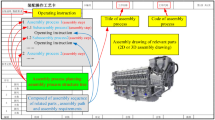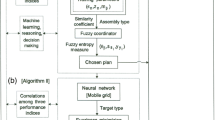Abstract
In this paper, a learning mechanism (LM) for parts recognition in an intelligent assembly system is presented. It differs from the mechanism used in the standard back propagation (SBP) neural network in two ways. First, the searching direction is changed from the negative gradient direction to the variable metric direction. Secondly, the constant learning rate is changed to a variable optimal learning rate. The combination of these two improvements leads to the training process being greatly speeded up, and convergence is assured. Several application examples are presented. Results indicate that the proposed LM is superior to the SBP in learning speed, convergence and stability.
Similar content being viewed by others
References
J. Buurman and D. J. W. Bierhuizen, “A two stage object identification system in the deft intelligent assembly cell”,SPIE vol. 1386, Machine Vision Systems Integration in Industry, pp. 185–196, 1990.
P. J. Besl and R. C. Jan, “Three-dimensional object recognition”,Computer Surveys 17(1), pp. 75–145, March 1995.
Y. Liu, T. S. Huang and O. D. Faugeras, “Determination of camera location from 2D to 3D line and point correspondence”,IEEE Transactions on Pattern Analysis and Machine Intelligence 12(1), pp. 28–37, January 1990.
L.-L. Wang and W.-H. Tsai, “Camera calibration by vanishing line for 3D computer vision”,IEEE Transactions on Pattern Analysis and Machine Intelligence 13(4), pp. 370–376, April 1991.
M. W. Roth, “Survey of neural network technology for automatic target recognition”,IEEE Transactions on Neural Networks 1(1), pp. 28–43, March 1990.
H. Y. Xu and C. R. Baird, “Synergism of neural network and expert systems for system identification”,Expert System with Applications 5, pp. 25–33, 1992.
S. H. Huang, H.-C. Zhang, “Neural-expert hybrid approach for intelligent manufacturing: a survey”,Computer in Industry 26, pp. 107–126, 1995.
J. Sima, “Neural expert system”,Neural Networks, 8(2) 1995.
L. E. Scales,Introduction to Non-linear Optimization, Higher and Further Education Division, Macmillan publishers, 1985.
Y. Xiong, X. Qiao and D. Wang, “The measurement and three dimensional reconstruction for aircraft using image processing techniques”,Transactions of Nanjing University of Aeronautics and Astronautics, 10(1), December 1993.
Author information
Authors and Affiliations
Rights and permissions
About this article
Cite this article
Wu, P.S.Y., Yingen, X. A learning mechanism for parts recognition in an intelligent assembly system. Int J Adv Manuf Technol 13, 413–418 (1997). https://doi.org/10.1007/BF01179036
Issue Date:
DOI: https://doi.org/10.1007/BF01179036




